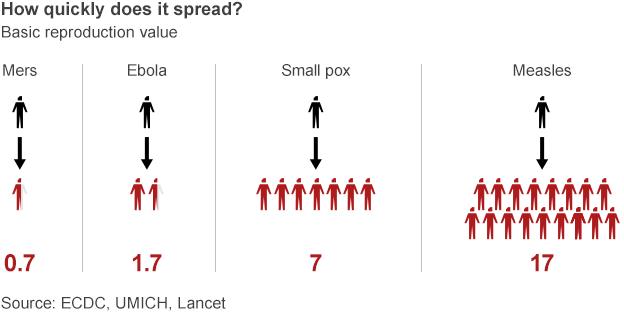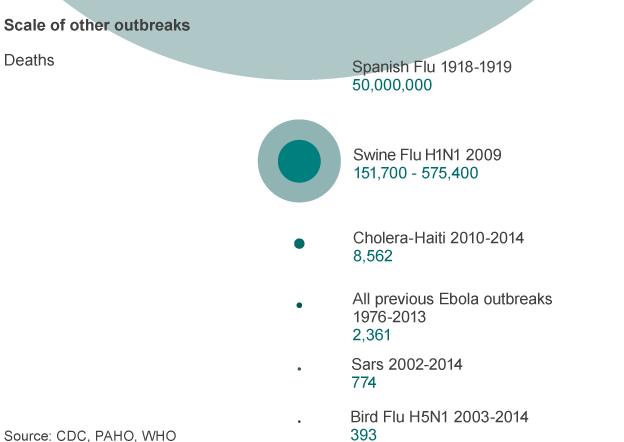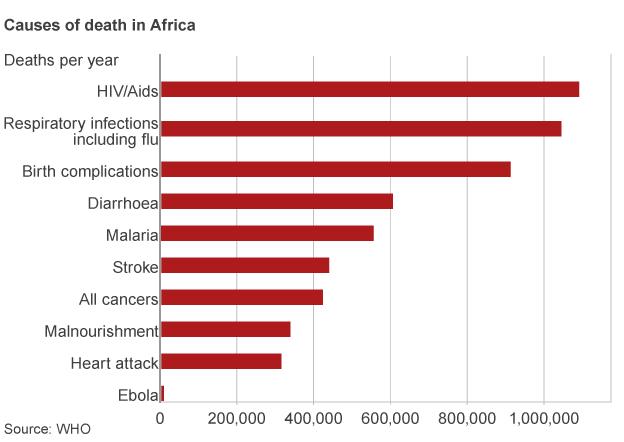Ebola: How does it compare?
- Published

The world has witnessed the largest-ever epidemic of Ebola claim thousands of lives in West Africa in 2014.
Since the first case, a two-year-old who passed away on 28 December 2013, external, there have been more than 6,900 deaths.
Outbreaks such as Ebola have an ability to spread fear around the world, often through the prism of sensationalist media reporting.
So how does Ebola actually compare to previous outbreaks and other diseases? And while the world focuses on Ebola, are we guilty of ignoring much bigger killers?
Deadly killer
Analysing the death rates from different viruses shows Ebola is certainly one of the most deadly infections ever encountered.

David Mabey, a professor of communicable diseases at the London School of Hygiene and Tropical Medicine, said: "The mortality rate from previous outbreaks is generally over 50% in Africa.
"Very few other viruses approach that apart from rabies which is 100% and Marburg which is in the same ballpark as Ebola."
But just because a virus is deadly does not mean it will cause a large number of deaths. It also has to infect new people.
This outbreak has shown Ebola does not spread as quickly as other infectious diseases.

The basic reproduction value represents how many other people an infected person passes their disease onto.
The value must be greater than one for a virus to spread, otherwise an outbreak will peter out.
The Mers-coronavirus, which keeps jumping from animals to people in Saudi Arabia, is an example of a virus unable to spread effectively in people.
Measles, meanwhile, is rampant and can explode through unprotected communities.
The total death toll of a disease depends on the combination of how rapidly a virus spreads and how deadly it is.
"It sounds slightly perverse, but a virus can cause less severe disease, but be a much bigger problem," said Prof Jonathan Ball, a virologist at the University of Nottingham.
Sars to flu
Looking at other headline-grabbing outbreaks, it is those that emerge and then spread with ease that pose global threats.
Eleven years ago another deadly virus - Severe acute respiratory syndrome known by its acronym Sars - had the world in a panic.
Western countries introduced screening at airports, as they have for Ebola.

Fewer than 800 people died from Sars out of 8,000 infected. Nearly 7,000 have died in this Ebola outbreak which has infected 18,000 people.
But the big killer in the global epidemics is influenza (flu) viruses.
Swine flu infected a fifth of the global population when it rapidly spread around the world in 2009.
It killed a tiny percentage of those people, but the global death toll may have been around half a million people.
But Prof Mabey draws an important distinction between flu and Ebola.
He told the BBC: "People who die of flu are mostly elderly people with other co-morbidities.
"That's the really terrifying thing about Ebola you can be a perfectly fit 20 year-old and be dead within 10 days."
The bigger picture
Even at the height of this epidemic, Ebola is far from a major killer in Africa.
It takes HIV/Aids just two days to kill as many people as have died in the whole Ebola outbreak so far.

In previous years, Ebola has caused even fewer deaths, which goes some way towards explaining why there is no cure or vaccine as there are bigger targets to aim for.
Huge progress has been made in HIV which is almost a manageable condition with the right drugs. Similarly, malaria is now killing half as many people as in 2001 thanks to improved interventions.
But Prof Ball argues it is right that Ebola is getting so much aid and research attention now.
"I think the reality is that we're not giving it disproportionate attention as this is something we know we can stamp out.
"The effort we expend now is preventing something bigger on a pan-African or even a global scale.
"This is a problem we can actually sort out, not doing so would be tantamount to stupidity really."